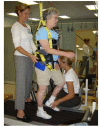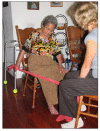Protocol for the Locomotor Experience Applied Post-stroke (LEAPS) trial: a randomized controlled trial
- PMID: 17996052
- PMCID: PMC2222229
- DOI: 10.1186/1471-2377-7-39
Protocol for the Locomotor Experience Applied Post-stroke (LEAPS) trial: a randomized controlled trial
Abstract
Background: Locomotor training using body weight support and a treadmill as a therapeutic modality for rehabilitation of walking post-stroke is being rapidly adopted into clinical practice. There is an urgent need for a well-designed trial to determine the effectiveness of this intervention. The objective of the Locomotor Experience Applied Post-Stroke (LEAPS) trial is to determine if there is a difference in the proportion of participants who recover walking ability at one year post-stroke when randomized to a specialized locomotor training program (LTP), conducted at 2- or 6-months post-stroke, or those randomized to a home based non-specific, low intensity exercise intervention (HEP) provided 2 months post-stroke. We will determine if the timing of LTP delivery affects gait speed at 1 year and whether initial impairment severity interacts with the timing of LTP. The effect of number of treatment sessions will be determined by changes in gait speed taken pre-treatment and post-12, -24, and -36 sessions.
Methods/design: We will recruit 400 adults with moderate or severe walking limitations within 30 days of stroke onset. At two months post stroke, participants are stratified by locomotor impairment severity as determined by overground walking speed and randomly assigned to one of three groups: (a) LTP-Early; (b) LTP-Late or (c) Home Exercise Program -Early. The LTP program includes body weight support on a treadmill and overground training. The LTP and HEP interventions are delivered for 36 sessions over 12 weeks. Primary outcome measure include successful walking recovery defined as the achievement of a 0.4 m/s gait speed or greater by persons with initial severe gait impairment or the achievement of a 0.8 m/s gait speed or greater by persons with initial moderate gait impairment.LEAPS is powered to detect a 20% difference in the proportion of participants achieving successful locomotor recovery between the LTP groups and the HEP group, and a 0.1 m/s mean difference in gait speed change between the two LTP groups.
Discussion: The goal of this single-blinded, phase III randomized clinical trial is to provide evidence to guide post-stroke walking recovery programs.
Trial registration: NCT00243919.
Figures




References
-
- Post-stroke rehabilitation: assessment, referral, and patient management. U.S. Department of Health and Human Services Public Health Service. Agency for Health Care Policy and Research. Clin Pract Guidel Quick Ref Guide Clin. 1995:1–32. - PubMed
-
- Perry J, Garrett M, Gronley JK, Mulroy SJ. Classification of walking handicap in the stroke population. Stroke. 1995;26:982–989. - PubMed

